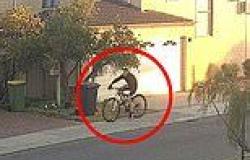Scientists have spotted a massive crack running through one of the most prominent glaciers in northwest Greenland.
Ice flow at the Petermann Glacier has been speeding up over the past few years, and satellite images now suggest a new iceberg could break free sometime in the near future.
Petermann is one of just three glaciers in Greenland that has an ice tongue – a 43-mile floating expanse that stretches into the Petermann Fjord.
Scroll down for video

According to a new study led by AWI, the recent acceleration was spurred by the loss of a large iceberg back in August 2012 (shown on left). According to the models, a similar phenomenon could occur if another piece breaks off. Recent satellite images (right) show massive cracks that could signal a calving event
Glacier calving is a natural occurrence caused by the forward motion of a glacier making its end unstable.
During a calving event, part of the end of a glacier drops off, often forming an iceberg.
Calving of glaciers is often accompanied by a loud cracking or booming sound before blocks of ice up to 60 metres (200 ft) high break loose and crash into the water.
The entry of this ice into the water can cause large and hazardous waves.
‘The satellite data shows that Petermann Glacier had a flow speed of roughly 1135 meters per year in the winter of 2016,’ said glaciologist Niklas Neckel, from the Alfred Wegener Institute, Helmholtz Centre for Polar and Marine Research (AWI).
‘That equates to an acceleration of about 10 percent in comparison to the winter of 2011, and we asked ourselves what was responsible for the increased speed.’
According to a new study led by AWI, the recent acceleration was spurred by the loss of a large iceberg back in August 2012.
And, according to the models, a similar phenomenon could occur if another piece breaks off.
‘On their way to the sea, the glacier’s ice masses rub along the rock walls that enclose the







